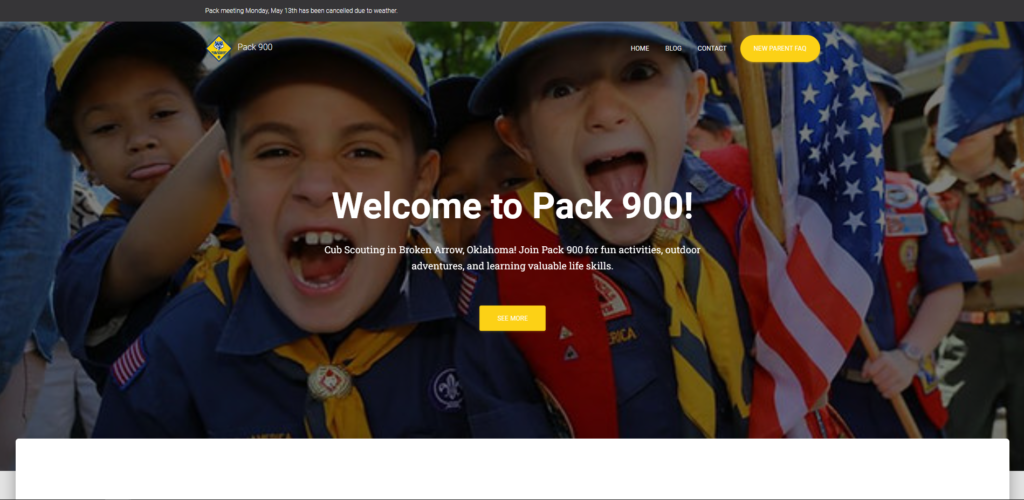As many of you know, I’m currently in the process of developing a website for the Broken Arrow Cub Scouts pack. One of the initial steps I took was keyword research. After all, the logic goes: understand what people are searching for, build a website that attracts that traffic, success! Right?

Initial Keyword Research
The keyword research results were a bit surprising. I meticulously explored every conceivable variation (including the larger nearby city):
| Keyword | Avg. Monthly Searches |
|---|---|
| broken arrow cub scouts | 0 – 10 |
| ba cub scouts | 0 – 10 |
| broken arrow scouts | 0 – 10 |
| ba scouts | 0 – 10 |
| cub scouts broken arrow | 0 – 10 |
| cub scouts ba | 0 – 10 |
| scouts broken arrow | 0 – 10 |
| scouts ba | 0 – 10 |
| ba boy scouts | 0 – 10 |
| broken arrow boy scouts | 0 – 10 |
| boy scouts ba | 0 – 10 |
| boy scouts broken arrow | 0 – 10 |
| cub scouts tulsa | 10-100 |
| tulsa cub scouts | 0 – 10 |
| scouts tulsa | 0 – 10 |
| tulsa scouts | 0 – 10 |
| pack 900 | 0 – 10 |
| pack 900 scouts | 0 – 10 |
| pack 900 cub scouts | 0 – 10 |
The search volume for these terms was practically nonexistent. We’re talking literally zero to ten searches a month. The main exception being the Tulsa Scout Shop which has 100-1k searches per month. (But not really relevant to our pack.)
Now, this doesn’t necessarily mean there’s a lack of interest in the Broken Arrow Cub Scouts program. However, it suggests that search traffic shouldn’t be the primary focus for this website.
Understanding Direct Traffic
The Cub Scouts aren’t relying on random internet searches to recruit new members. Their outreach efforts are more focused on local events, flyers, and leveraging their existing network of families. My family joined because of word of mouth and a recruiting event at school.
This is where the concept of direct traffic comes into play.
For those who are newer to the development world, direct traffic simply refers to instances where visitors arrive at a website by either typing in the address directly or clicking on a link that leads them there. In the case of the Broken Arrow Cub Scouts website, this is exactly what we want to achieve. We want parents and kids who already have an interest in the program to easily find the website.
Here are some strategies we can implement to make this happen:
- Recruiting Events and Flyers: Print the website address prominently on all flyers and posters used for recruiting events. When parents approach the booth to inquire, ensure they know exactly where to go for more information.
- Social Media: Our pack has an established social media account, so we can strategically incorporate the website link within bios and relevant posts.
- Word-of-Mouth Marketing: Encourage current Scout families to share the website with friends and neighbors who might be interested in joining the program.
Prioritizing New Scout Information
The initial keyword research was a little surprising about search volume. But it ultimately helped me refine our website’s primary objective. Here, the focus isn’t on attracting a broad audience through search engines, but rather on providing crucial information to new parents as quickly and efficiently as possible.
Imagine a scenario where a parent, intrigued by the Cub Scouts program after a school event or a conversation with a neighbor, decides to seek more details online. Our website should be the first and most valuable resource they encounter.
To achieve this, the website will prioritize clear and concise information about the Broken Arrow Cub Scouts program, its activities, and the registration process. Think of it as a digital brochure readily accessible at any time.
Adapting After Keyword Research
Now, this doesn’t mean I’m abandoning SEO entirely. Even with a direct traffic focus, there’s still value in optimizing the website for search engines. Here’s why:
- Unforeseen Discoverability: While search traffic might not be the primary driver, there’s always the possibility that people might find the website through unexpected search queries. Optimizing for relevant keywords can still capture these potential new families.
- Data-Driven Decisions: By implementing SEO best practices and website analytics tools, we can gain valuable insights into how visitors are actually finding the website. Perhaps there are specific keywords or search terms driving more traffic than anticipated. This data can inform future website adjustments and outreach strategies.
In essence, I’m taking a flexible approach. We’ll prioritize direct traffic strategies while still maintaining a foundation of search engine optimization. The website analytics will become our compass, guiding us in refining the website’s content and outreach efforts to best serve the Broken Arrow Cub Scout community.